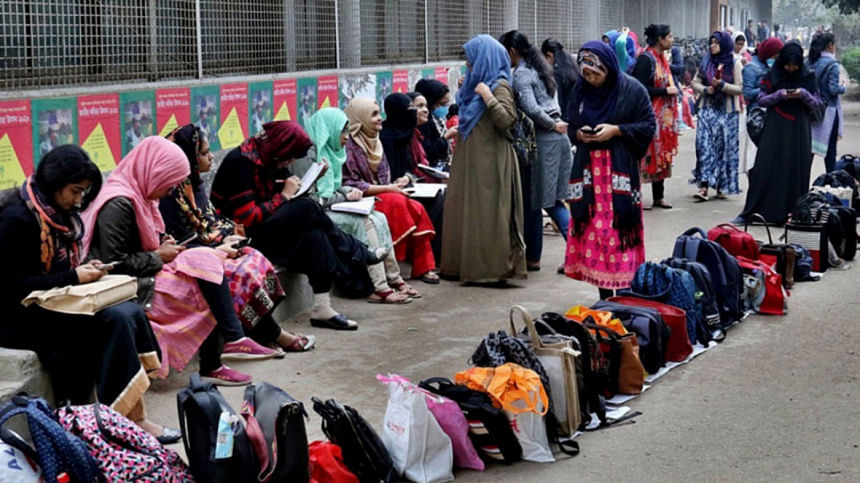Are we underutilising the potential of our youth?

According to the most recent census, Bangladesh now has the highest youth population that it has ever had. With individuals aged 15 to 29 years accounting for approximately 28 percent of the total population, the country is on the verge of an exceptional opportunity to boost its economic growth.
However, the road towards this is not without challenges. According to the Labour Force Survey 2016-17, a staggering 79.7 percent of the unemployed population is young people, and perhaps even more concerning is that 89.2 percent of youth employment is in the informal sector. This status quo paints a stark picture of a country falling short of capitalising on its most potent asset: its youth.
On the demand side, structural changes and technological advancement in Bangladesh's economy have driven a need for certain sets of new hard and soft skills. Professional skills like networking, critical thinking, numeracy, and English language proficiency have now emerged as lucrative commodities. Add to this the escalating flow of fresh graduates entering the labour market, and the situation seems decidedly competitive. Unfortunately, this influx has not been met with an equivalent increase in job creation – mostly due to limited private-sector investment, minimal diversification in manufacturing, and barriers to foreign direct investment.
The obstacles to youth economic engagement are as multifaceted as they are complex. At the core of this issue lies a profound skills gap – a disconnect between the skills our education system offers and those demanded by employers in the labour market. This is evident from the 11.2 percent unemployment rate among youth with tertiary education, compared to the national unemployment rate of 3.6 percent according to the LFS 2022. Vocational and technical training have been found to be inadequate, with low contact hours and equipment shortages impeding skills development.
The disparities extend to internet access, which is an indispensable tool in modern knowledge-based economies. As per the Youth Survey 2018 conducted by BRAC Institute of Governance and Development (BIGD), a mere 40 percent of young people had access to the internet, with an even lower rate among young women. This digital divide is increasing the education and employment gap between urban and rural youth, effectively creating two distinct classes with varied development opportunities.
Gender disparity is another issue that cannot be ignored in this discourse. With the substantial constraints of social stigma and cultural norms, 92 percent of female youth in Bangladesh fall under the category of NEET (not in education, employment or training). This is particularly alarming since the 2022 Population and Housing Census revealed that females comprise 50.5 percent of the total population and 53.7 percent of the 15-to-29-year cohort. According to a 2018 report by the Centre for Policy Dialogue (CPD), on average, each additional hour spent doing household tasks increases the chances of entering NEET status by 0.16 percent for female youth.
On top of all these, the Covid-19 pandemic intensified the state of inequity and access, causing unprecedented learning losses and creating a misaligned labour market environment.
The Bangladesh government has a pivotal role to play in leading the nation towards correcting the mismatch between skills demanded and supplied. Prioritising investment in quality education, and vocational, and technical training will facilitate a much-needed structural transformation towards a more productive youth labour force for highly productive sectors. Meanwhile, providing the youth with easy access to funding and information to start their businesses can boost employment.
On the other hand, youth must proactively align their skills with the ever-evolving labour market and learn to market themselves professionally and utilise digital platforms like LinkedIn. Moreover, they must adopt a positive attitude towards vocational and technical training and labour-intensive jobs, which have more demand than supply in the market.
The community has a crucial role to play as well. By encouraging the completion of education and ensuring access to employment opportunities for disengaged or left-behind youth, the community can be a crucial catalyst for socio-economic upliftment. Furthermore, altering the deep-rooted social norms that inhibit women's workforce participation is a collective responsibility we must shoulder. Through collective action, we can dismantle the social barriers that prevent females from participating in the workforce and ensure that no one is left behind.
To say that the stakes are high would be an understatement. With a booming youth population, Bangladesh now has a once-in-a-lifetime opportunity to leapfrog into a higher growth trajectory. This responsibility is on us all – the government, the youth, and the community collectively should surmount these challenges and realise our demographic dividend's full potential.
Ifaz Kabir is a director at WARA Ltd.

 For all latest news, follow The Daily Star's Google News channel.
For all latest news, follow The Daily Star's Google News channel. 











Comments